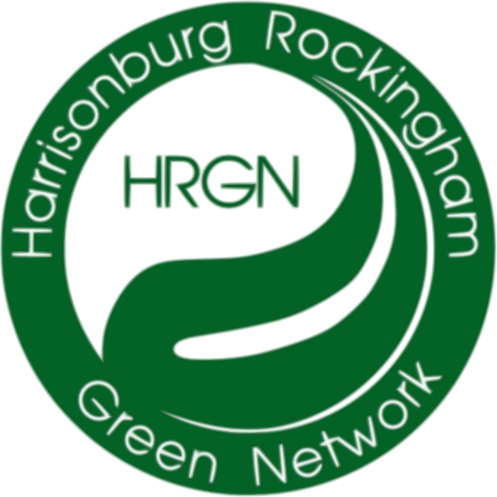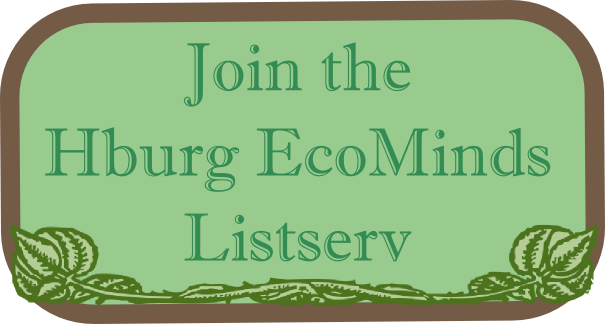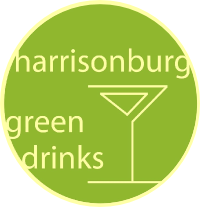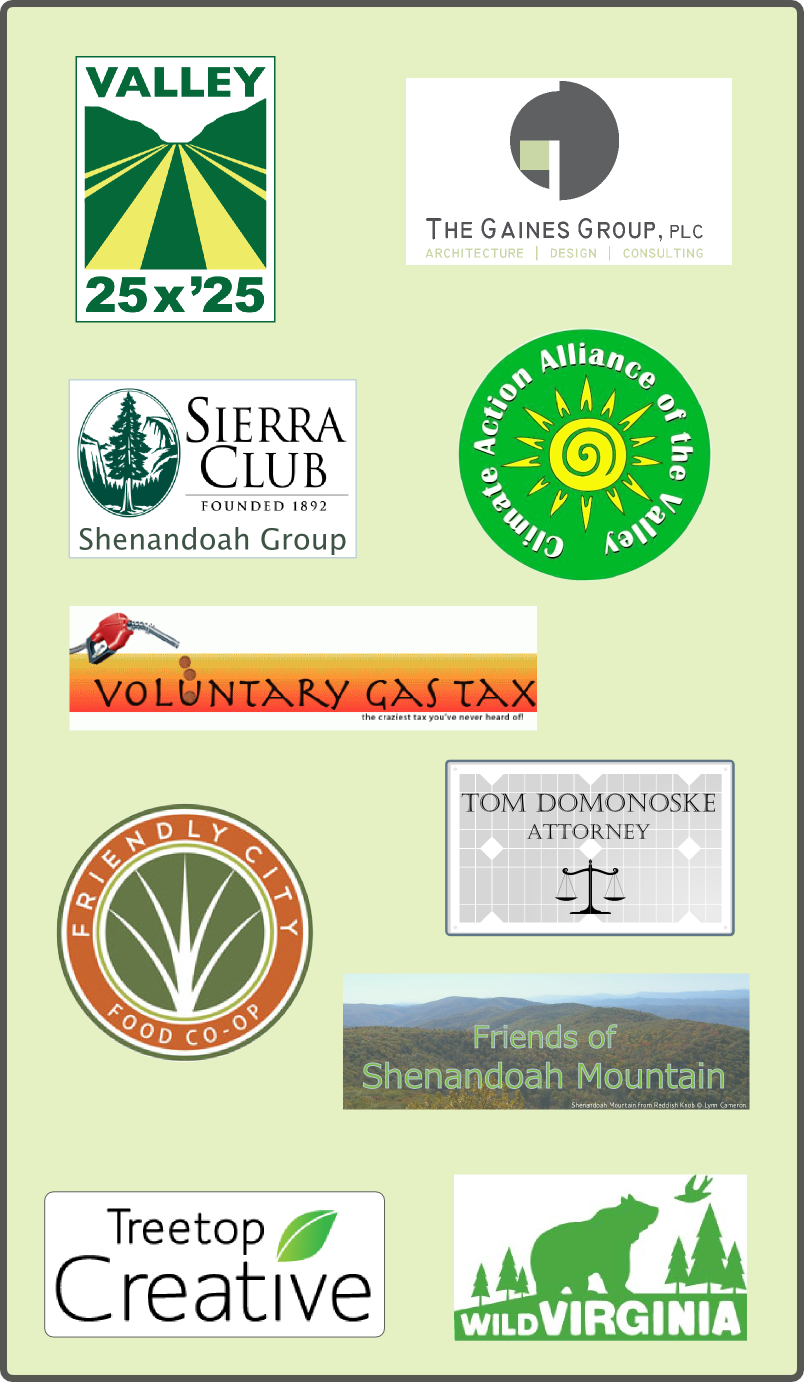With Warming, East Coast Forests Sequester More CO2 Reposted from Wild Virginia.
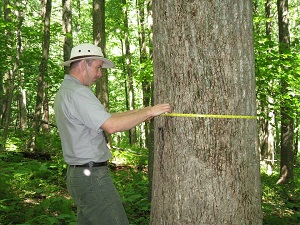 Vegetation Monitoring Crew member in Shenandoah National Park, 2021. As a human species, we seem to be doing our best to overwhelm the natural balances of the earth: we waste about 1/3 of all food produced (and up to 40% in the U.S.), we cut down 46-58,000 square miles of forest a year, and scientists predict global temperature increases as high as 8.6° by 2100. Yet, despite ourselves, the earth is still trying to correct our mistakes.
Recent research published in Nature Climate Change shows that extended growing seasons in East Coast forests due to increasing temperatures actually increases the amount of carbon that the forests can absorb. Because the trees are “leafing out earlier in the spring” and holding onto leaves later into the fall, the forests have an extended time to undergo the photosynthesis process (which intakes carbon to make glucose, for those of us needing a 9th grade biology refresher). While increased temperatures also means increased respiration (a process that produces carbon dioxide), this study shows that the two processes together still create a net increase of carbon dioxide storage.
However promising this news may be, this research only accelerates the necessity to keep East Coast forests intact. Threats to our forests abound, including logging, biomass removal, fracking and natural gas infrastructure. The NOAA report on the study warns:
Forests may help reduce the growth rate of atmospheric carbon dioxide and slow future warming. But at the same time, climate change is increasing the vulnerability of many U.S. forests to fire, insect infestations, drought, and disease outbreaks. These disturbances raise the potential for large releases of carbon dioxide back into the atmosphere.
Protecting our forests, and forests worldwide, is critical to mitigate climate change and atmospheric carbon. Wild Virginia works everyday to preserve our Natural Forests, raising our voice against logging, pipelines, and habitat destruction. We’re anything but alone in this fight. Our friends at Dogwood Alliance are leading the charge against logging and biomass removal in Southern U.S. forests. Appalachian Voices fights against mountaintop removal coal mining, which strips mountain ecosystems in the Appalachian mountains. While our forests are doing their best to survive and adapt to man-made changes, we must ensure that these forests thrive.
The forests we protect, in turn, protect us.
Image credit: Shenandoah National Park.
Dreaded Atlantic Coast Pipeline Application Filed on 9/18/15 Reposted from Friends of Shenandoah Mountain, September 19, 2021
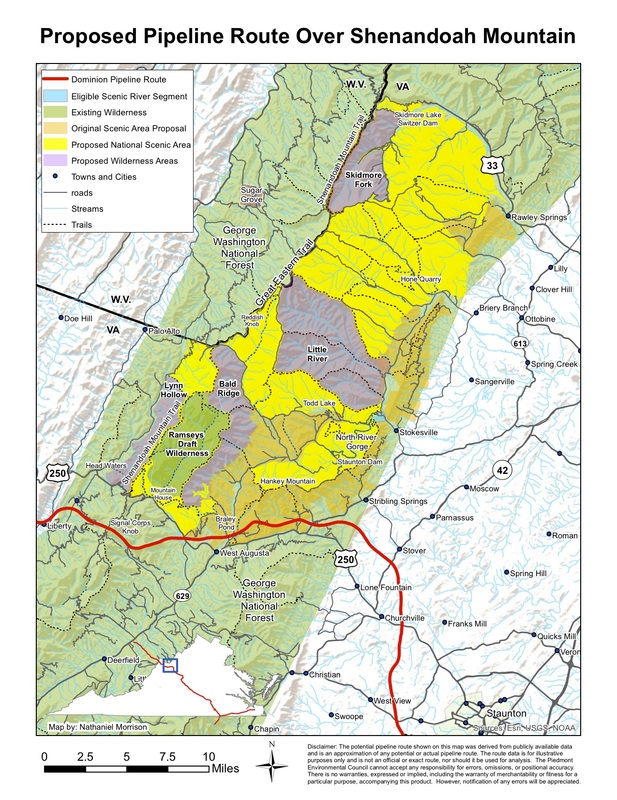 Dominion Resources and its partners filed an application with FERC (Federal Energy Regulatory Commission) on Sept. 18 to build the Atlantic Coast Pipeline (ACP). The proposed ACP route crosses Shenandoah Mountain south of Rt. 250 through Cow Knob Salamander habitat and then passes through the corner of our proposed Shenandoah Mountain National Scenic Area near Ramseys Draft Wilderness and Braley Pond. The pipeline threatens the scenic beauty, wildlife habitat, and recreational resources that make Shenandoah Mountain such an excellent candidate for Congressional designation. The Shenandoah Mountain National Scenic Area proposal has been endorsed by over 230 businesses, organizations, and faith groups and has been recommended by the GWNF (George Washington National Forest) in its new plan. Dominion Resources and its partners filed an application with FERC (Federal Energy Regulatory Commission) on Sept. 18 to build the Atlantic Coast Pipeline (ACP). The proposed ACP route crosses Shenandoah Mountain south of Rt. 250 through Cow Knob Salamander habitat and then passes through the corner of our proposed Shenandoah Mountain National Scenic Area near Ramseys Draft Wilderness and Braley Pond. The pipeline threatens the scenic beauty, wildlife habitat, and recreational resources that make Shenandoah Mountain such an excellent candidate for Congressional designation. The Shenandoah Mountain National Scenic Area proposal has been endorsed by over 230 businesses, organizations, and faith groups and has been recommended by the GWNF (George Washington National Forest) in its new plan.
The Cow Knob Salamander is a sticky issue for the ACP. Its habitat is protected by a Conservation Agreement signed in 1994 by the USFS (US Forest Service) and US Fish & Wildlife. GWNF Forest Supervisor Tom Speaks sent a letter to FERC on Sept. 17 asserting that the ACP is not in compliance with the Conservation Agreement for this species which is “at high risk for extinction or extirpation.” Supervisor Speaks added that “project effects on Cow Knob and Cheat Mountain salamanders must be avoided and cannot be mitigated.”
Read GW Supervisor Tom Speaks’ letter to FERC.
Read about the Cow Knob Salamander: Potential Impact of the ACP
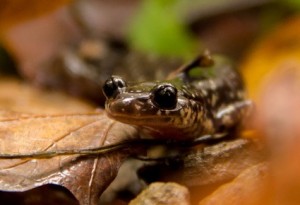 Many thanks to Eastern Mennonite University conservation photography students who partnered with Friends of Shenandoah Mountain in Oct. 2014 to photograph the Cow Knob Salamander in the path of the pipeline. Their photographs provide undeniable evidence of the existence of these rare creatures along the pipeline route. See some of their photos. Many thanks to Eastern Mennonite University conservation photography students who partnered with Friends of Shenandoah Mountain in Oct. 2014 to photograph the Cow Knob Salamander in the path of the pipeline. Their photographs provide undeniable evidence of the existence of these rare creatures along the pipeline route. See some of their photos.
Image at right is of a Cow Knob Salamander on Shenandoah Mountain by EMU student Malika Davis.
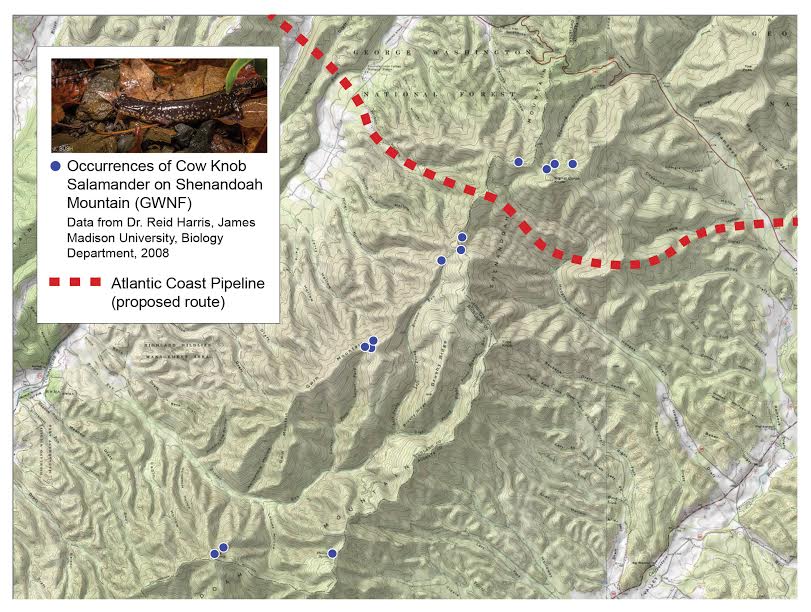 ACP route across Shenandoah Mountain through Cow Knob Salamander habitat. Photo of Cow Knob Salamander by J. Bush, EMU student
Future Bluestone Trail Extension Reposted from the Shenandoah Valley Bicycle Coalition, September 16, 2021
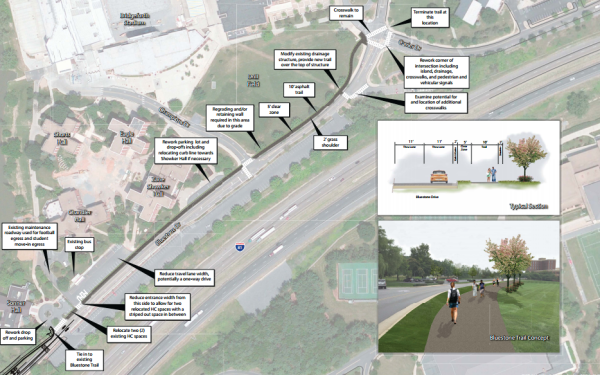
In 2015, the City of Harrisonburg and James Madison University were awarded $364,500 from Virginia Department of Transportation (VDOT) Revenue Sharing funds to extend the Bluestone Trail from Sonner Hall to Carrier Drive on JMU campus. The City is administering the project and JMU is providing matching funds in the amount of $364,500.
Vanasse Hangen Brustlin, Inc (VHB) was selected to provide engineering services for this project. The new trail is 0.27-miles long. Construction is anticipated to begin and complete in Summer 2016. More details of the project can be found on the City of Harrisonburg website
In the Daily News Record on September 16, 2021:
Construction Begins Next Summer On Bluestone Path Extension Through JMU
Posted: September 16, 2021
By RACHEL CISTO
The extension of the Bluestone Trail is expected to begin next summer. It will go from Sonner Hall to Carrier Drive on James Madison University’s campus. The Virginia Department of Transportation will cover half the cost of the $729,000 project.
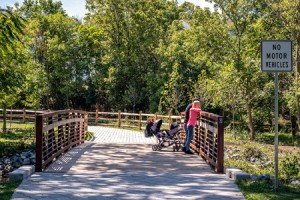 (9/15/15) – (Harrisonburg)
Tiffany and Alex Rodriguez, of Harrisonburg, stop to look over a bridge during their walk on Bluestone Trail Tuesday, September 15 .
(Austin Bachand/Daily News-Record) HARRISONBURG — Construction is expected to begin next summer on an extension of Bluestone Trail in the city.
The project, expected to cost $729,000, is being paid for by a revenue-sharing grant from the Virginia Department of Transportation, according to Tom Hartman, Harrisonburg’s assistant director of public works.
It would extend the trail from Sonner Hall to Carrier Drive on the James Madison University campus.
VDOT announced the funding was awarded in June as part of the fiscal 2016 revenue-sharing program.
The Bluestone Trail was included in Harrisonburg’s 2010 bicycle and pedestrian plan, and work began in 2012.
The existing trail, which opened in October, runs 1.1 miles from the Sentara RMH Wellness Center on Stone Spring Road to the university’s Port Republic Road entrance at Bluestone Drive. Along the way, it bisects Purcell Park.
The 10-foot-wide, hard-surface path is designed for runners, walkers and bicyclists.
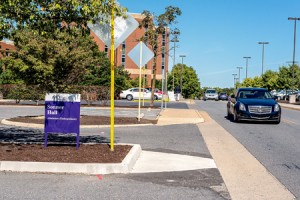 (9/15/15) – (Harrisonburg)
The new extension to Bluestone Trail will begin at Sonner Hall and end at Carrier Drive.
(Austin Bachand/Daily News-Record) The extension will stretch north through campus from Sonner Hall along Bluestone Drive. It will cross Champions Drive and end at Bluestone Drive’s intersection with Carrier Drive.
According to the city’s plan, that intersection will be reworked, including improvements to drainage, crosswalks and signals.
The new section would build on the shared-use path installed during the university’s Newman Lake dam
reinforcement project completed earlier this year, from Port Republic Road to Sonner Hall.
The university approached the city about extending the shared-use path from Newman Lake earlier this year.
JMU applied for the state funding through the city of Harrisonburg, Hartman said, and received $364,500. The city will administer the project, and the school will pay the other $364,500 to complete the pathway.
Initially, extending the trail farther onto JMU’s campus was planned to occur later in the project, Hartman said. The work was moved up after the university was successful in its grant application.
“This wasn’t necessarily ‘phase two,’ but it made more sense to continue it north into JMU,” Hartman said.
Hartman said city officials have no timeline for Bluestone Trail’s second phase, which will extend south from Stone Spring Road to Ramblewood Park.
“We have ideas, and we know how to get it to go where we need it to go,” he said. “It’s just getting the funding.”
Hartman said city officials are excited about the trail.
“It’s better connecting the park and the city to JMU,” he said. “We’ve gotten a lot of good feedback from the community about it.”
Contact Rachel Cisto at 574-6272 or rcisto@dnronline.com
Home Energy Audits in Harrisonburg City Reposted from Design Matters, The Gaines Group: Harrisonburg Architect by Charles Hendricks, April 1, 2021.
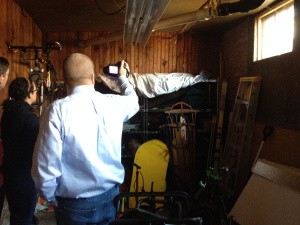 I am now performing Home Energy Audits for Harrisonburg Electric Commission (HEC). These are base line / help you reduce your monthly electric bills / more of an air leakage test than full energy audit kind of review for your home. The advantage – they are FREE to HEC customers that have electric heat in their homes. I am now performing Home Energy Audits for Harrisonburg Electric Commission (HEC). These are base line / help you reduce your monthly electric bills / more of an air leakage test than full energy audit kind of review for your home. The advantage – they are FREE to HEC customers that have electric heat in their homes.
The kinds of things we are looking for are easy things the home owner can do to lower monthly electric usage. You simply need to call HEC to schedule the appointment. It takes us about an hour to set up the blower door and walk through the house looking for air leakage patterns. We use thermal imaging camera technology to see through the walls. We also have been able to catch a couple of water leaks that were not yet visible. We leave a short checklist of things for you to do to improve your thermal envelope after our audit.
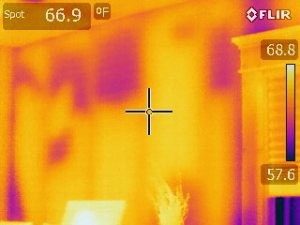 Once you have done the easy things you could potentially reduce your monthly electric bills by up to 30% depending on what we find during the audit. Note, this is not an exhaustive audit. For a more complete audit you need to call Building Knowledge. However, start with the base line audit that HEC provides for free. We are proud to partner with HEC on this effort. Once you have done the easy things you could potentially reduce your monthly electric bills by up to 30% depending on what we find during the audit. Note, this is not an exhaustive audit. For a more complete audit you need to call Building Knowledge. However, start with the base line audit that HEC provides for free. We are proud to partner with HEC on this effort.
More here: https://www.harrisonburgelectric.com/programs/energy_audit/
Hello Harrisonburg Hits Town  Former Mayor and current City Council member Kai Degner launched a new communication tool on June 1, 2021, in the way of a local podcast focused on Harrisonburg. Hello Harrisonburg features one-on-one conversations between Kai and local leaders, designers, entrepreneurs, business owners, activists, educators … to help tell the story of Harrisonburg, VA. Former Mayor and current City Council member Kai Degner launched a new communication tool on June 1, 2021, in the way of a local podcast focused on Harrisonburg. Hello Harrisonburg features one-on-one conversations between Kai and local leaders, designers, entrepreneurs, business owners, activists, educators … to help tell the story of Harrisonburg, VA.
About 30 minutes each, Hello Harrisonburg episodes embrace themes which so far have included Downtown Revitalization, Innovation & Economic Development, and for the week of June 28- July 3: Sustainability.
Sustainability interviewees were (click on the name to access their podcast):
Charles Hendricks of The Gaines Group kicks off this week’s five-episode Sustainability Week with an information-rich interview focused on how his architectural services can make residential and commercial buildings energy efficient, durable, and healthy. Charles is a United States Green Building Council LEED Accredited Profession, and a National Home Builders Association Certified Green Professional and Certified Aging-in-Place Specialist.
Tune in to hear how Charles designed a 4,000 square-foot Crossroads Farm home that has a $150/mo electric bill (half of which is for the jacuzzi!). Also, hear how Thomas Jefferson’s plan for UVA’s Academic Village inspired Charles’ work.
How did a political science and journalism student become a general manager at the Friendly City Food Coop and an advocate for sustainable food systems? Tune in and find out! This episode of Hello Harrisonburg features Steve Cooke, General Manager of the Friendly City Food Coop, who shares a ton of great examples of how FCFC is contributing to making Harrisonburg a more sustainable place.
Tom Domonoske was the first person in Harrisonburg to install photovoltaic solar arrays on a Harrisonburg residential property, be linked with the electric grid, and set up net-metering with the Harrisonburg Electric Commission. Tom is an attorney focused on consumer credit work, involved in predatory lending, improper foreclosure, and other consumer protection cases. He joins Hello Harrisonburg for Sustainability Week to share his perspective on sustainability actions being driven by saving dollars, increasing personal freedom, and waking up happy.
Alleyn Harned takes Sustainability Week on the road. As Executive Director of Virginia Clean Cities, a nonprofit devoted to promoting alternative fuel vehicles and technologies in Virginia, Alleyn is working at the intersection of policy, markets, and technology. He and his team partner with private companies and governmental entities to make fleet-level switches away from solely diesel and gasoline powered vehicles towards a range of alternate fuel options.
Hear about Virginia Clean Cities work to install the first electric vehicle charger in Harrisonburg, plus other alternative fuel success stories from around the Commonwealth.
Hear Ros O’Brien discuss her motivation and plans for inspiring individual contributions towards promoting sustainable lifestyles in Harrisonburg and elsewhere.
Ros discusses www.SustainHburg.com, a website she created and maintains with other volunteers to share sustainability projects, ideas, and advocates. Learn how to get involved by contacting her! And, Ros announces plans to start a Sustain Hburg book club – check the Sustain Hburg website, Facebook page, and newsletter for updates.
Hello Harrisonburg is a platform to keep conversations and meaningful dialogue flowing and for community members to make connections … not unlike one of Kai’s previous projects, The OrangeBand Initiative.
WMRA: Clean Virginia Series 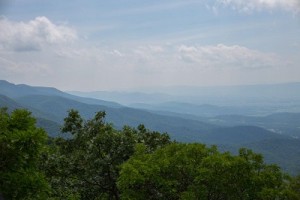 View from Mary’s Rock in Shenandoah National Park by Kara Lofton Freelance reporter Kara Lofton has completed an 8 part series on environmental issues affecting Virginia as reported on WMRA.
The series sets out to “… explore the state of Virginia’s unique environment, specifically its water, air and soil. How does agriculture affect our drinkable water, and the health of the Chesapeake Bay watershed? How well are we doing cleaning up industrial pollutants such as mercury? Are decades-old problems, such as acid rain and runoff from coal-fueled power plants, getting solved? How clean is the air we breathe?”
Find Kara’s reports for this series here:
Keeping Cattle Away from Streams: Clean Virginia, Part 1, May 31, 2021
Clean the Bay Day: Clean Virginia, Part 2, June 4, 2021
Power and Water: Clean Virginia, Part 3, June 11, 2021
Honeybee Health in Virginia (Clean Virginia, Part 4), June 18, 2021
The Legacy of Mercury (Clean Virginia, Part 5), June 24, 2021
Acid Rain, Trout, and the Clean Air Act (Clean Virginia, Part 6), July 2, 2021
Virginians Are Breathing Easier (Clean Virginia, Part 7), July 8, 2021
Solar Power Trends (Clean Virginia, Part 8), July 29, 2021
Earth Day…and Beyond! April is a wonderful “green” month in a variety of ways. Spring is springing a little late this year, so April is the month of buds and blossoms, of starters and sprouts. We can see more people out in their gardens, jogging, walking, biking, and congregating in any number of places without roof and walls. It is a great time to bask in the greenness of the Valley.
April is also the month of Earth Day. Though it comes later in the month, Earth Day lends inspiration to events many weeks before and after the holiday itself. And this year is no exception.
Our HRGN Calendar has a satisfyingly full list of green events going on throughout April. Whether you want to learn more about fracking, get your hands dirty with the Blacks Run Cleanup, or learn about extreme weather, you have lots of options to go green this month. Check out our Calendar to learn about these and many other green events this month and every month.
As much fun as Earth Day is, sustainability is something that needs to be central in our lives every day. We as individuals can do a lot to make greener lifestyle choices–in our diets, in our transportation, in the products we buy, in the clothes we where, in the places we live…
On a larger level, cities can also make great strides to be more sustainable places. Cities around the nation are adding the position of Sustainability Coordinator to their staff, to help navigate a greener course in local government policies and initiatives. Roanoke is a local example.
Members of HRGN and other Harrisonburg residents are currently working to bring a Sustainability Coordinator to Harrisonburg. As Climate Action Alliance of the Valley (a HRGN member organization) shows, a Sustainability Coordinator would have a number of key tasks, such as developing a sustainability plan, coordinating and enhancing resource management and pollution control, and much more.
If Harrisonburg had a Sustainability Coordinator, that would mean someone whose job it was to think about making every day in Harrisonburg greener. Sure, not all days are about sprouts and blossoms, but every day can be more sustainable with effort, education, and focus. Thankfully, all of these are available…and a Sustainability Coordinator could help keep the City motivated by all of these…to help it be not only the Friendly City, but also a GREEN city.
Do you support hiring a Sustainability Coordinator for Harrisonburg? If so, contact City Council to let them know!
Eat Your Grass The title of this article probably does not make a lot of sense…nor should it. Most of us, unless we are rabbits or worms or another type of critter, tend towards greens like kale, lettuce, cabbage, and spinach. Yet we all have to eat, and if even a part of the iconic suburban lawn is devoted to a garden, that productive space is usually a fraction of the total green space on any given city property.
After all, growing food is for farmers, right?
In fact, lawns provide a rich and ready opportunity for one to transition from a consumer to a producer. They offer expanses of varying extent in which fescue and other inedibles can be replaced with vegetables, fruits, herbs, and many other types of edible plants, year ’round and close to home.
Indeed, how much more local can food get???
However, the idea of growing food, not lawns is still quite foreign to many people. It seems strange to have food plants, not ornamental plants, in the front yard (or the back yard, for that matter). Despite growing recognition that disconnection from our food, and the industrialization of the food system, harm people, animals, and the environment, there are still barriers (mental, cultural, and legislative) that make growing your own food on your own (or your neighbor’s) property difficult…potentially even illegal.
An exciting local initiative to allow horticultural businesses, aka “business gardens,” to grow food in residential neighborhoods is currently making its way to City Council, which will hear and vote on the proposal on March 12, 2021. (For more information about the proposal, read the Old South High blog and the City’s site for the proposal). If passed, this proposal would amend the City’s Home Occupation Permit to allow for “business gardens” in residential areas, and add an ordinance covering business garden regulations.
Collicello Gardens, run by JMU students Sam Frere and Dan Warren, provided both the spark for this legislative effort cum social movement and an example of just how positive and beneficial urban horticulture can be. They have turned nearly every patch of their rented yard into garden space for vegetables, fruits, and herbs. They, like other projects in Harrisonburg such as New Community Project, are proving that growing food is not something for farmers in the country. Growing our own food is a right each of us has to produce more–whether that be food, community, or inspiration for our neighbors. So are YOU ready to grow your own, too??? Support the Business Garden Proposal on March 12, and come out to a community discussion on Urban Gardening on March 25 (see below).
HR Green Tales: Shenandoah Group of the Sierra Club
The Sierra Club is the country’s oldest, and easily one of the best-known, environmental organizations. The legendary naturalist John Muir founded it in 1892, with a mission to preserve, protect, and enjoy nature. Since then, the Sierra Club has been a leader on a number of environmental initiatives aimed at reducing energy consumption, expanding the market for renewable energy, promoting sustainable living, preserving habitat, and more.
The organization’s local chapter, the Shenandoah Group of the Sierra Club, has over 750 members from throughout the Shenandoah Valley. To further the organization’s mission, the group focuses on education, political action, and offering people opportunities to get back to nature. Ralph Grove is the group’s chair. He has been involved with the Sierra Club for over 25 years and has played a key role in many local and statewide efforts—while also leading many of the group’s regular hikes!
As Ralph explains, John Muir “was a visionary in his time who realized the need to protect the most significant wild places in a new and growing country.” In modern times, the Sierra Club has worked hard to realize Muir’s vision and dedication. For example, in Virginia the organization launched the first offshore wind conference to promote development of wind energy, while also campaigning for meaningful changes to energy laws and renewable energy standards for public utilities. At a more local level, groups of the Sierra Club work on issues such as transportation, environmental justice in minority communities, and keeping the ban on uranium mining in place.
A characteristic of the Sierra Club is its efficacy in promoting positive change in laws, business, and society. Ralph explains, “Our Beyond Coal campaign has helped to shut down or block approval of over 100 coal-fired power plants across the nation, including several in Virginia.” In addition, they team up with groups such as Mountain Justice to prevent mountaintop removal mining. The Sierra Club also works to preserve scenic rivers and wilderness areas in Virginia. Ralph adds, “We’re closely involved in forest management, and helped to develop the new forest management proposal in partnership with many other groups involved in that process.”
Another hallmark of the Sierra Club is its “active” nature, which is evident in everything from its political campaigning, organizing rallies and other events, or sponsoring trips into the wild. The Shenandoah Group is no exception. “We engage in education through outreach efforts, locally and statewide,” Ralph says. “We engage in political campaigns and lobbying at the state and federal level (such as the upcoming rally in Washington, D.C. on February 17th). We also have an extensive outings program, which brings people from all over the state together for hiking, canoeing, and other outdoor activities.”
Of course, the Sierra Club faces significant challenges in executing its mission. One major challenge, according to Ralph, is that “the energy industry has enormous financial reserves, and they don’t hesitate to use them” in any number of ways. “We can’t match their money, unfortunately, and that gives them an edge in political contests.” Another challenge is getting enough people engaged in the political process and connected with the environment.
Despite the challenges, the national, state, and local arms of the Sierra Club are continuing to strengthen environmental protections and educate the public. Ralph says that ongoing campaigns in Virginia include promoting renewable energy and conservation-friendly energy policies and laws, maintaining the ban on uranium mining, protecting national forests, and fighting construction of new coal-fired power plants; nationally, the main focus is on reducing dependency on fossil fuels and promoting renewable energy.
Visit # to find out more about the Shenandoah Group of the Sierra Club…and watch out for them next time you are hiking!
Going Green in 2013 Last year, 2012, was the first full year of the Harrisonburg-Rockingham Green Network. It has been an amazing process, with many of the area’s leading green organizations, businesses, and individuals coming together to build the “network” and give it a mission. And muscle.
It was exciting to take part in and support some familiar community events, such as the Green Expo and Green Drinks, while also collaborating to create new events, such as the City Council Candidates Forum. As with any collective effort, things can move slowly at times…but for HRGN, 2012 was a year of encouraging accomplishments and steady progress.
Now we are in a new year, and the members of HRGN are looking forward to doing even more to help everyone in our community to go green in 2013. As many of us make resolutions for the new year, the members of HRGN can reflect on our mission and goals as a way to strengthen our resolve, motivate our actions, and foster our collaborative spirit. The mission and goals are as follows:
HRGN is organized for the public good for the purpose of creating a Sustainable Environment for all Citizens in Rockingham County and the City of Harrisonburg. To accomplish this purpose, we intend to:
1. Educate the public and government officials within our community about green issues.
2. Reduce the burden of local government by helping identify ways to promote environmental sustainability through energy efficiency, conservation, the use of renewable energy sources, promotion of local food systems, and fostering healthy natural systems.
3. Help local businesses, churches, and other organizations identify and implement strategies to become more energy efficient and sustainable in their practices and operation.
4. To the extent possible, devote time, energy, and a limited amount of our resources to advocate on legislation and/or regulation affecting energy efficiency, conservation, the use of renewable energy sources, promotion of local food systems, fostering healthy natural systems, or other types involving environmental sustainability.
Currently, HRGN offers the community some informative tools to help us accomplish this mission:
1. Our website (recently redesigned!) and Facebook pages.
2. Our monthly HRGN newsletter.
3. Our green calendar (on our website), listing upcoming green events.
4. Green events in the community.
5. Opportunities to join the network as a Member (organizations, businesses, etc.) or an Affiliate (individuals).
We hope that 2013 will be the greenest year yet for everyone. We encourage you to take part in this collaborative effort to make Harrisonburg-Rockingham, the Valley, and beyond a truly sustainable, joyful community in which to live!
|
|
